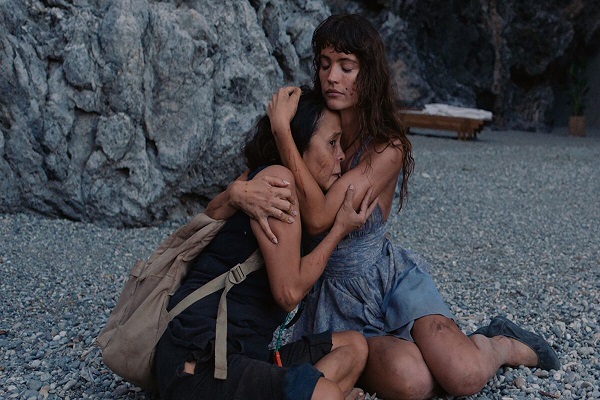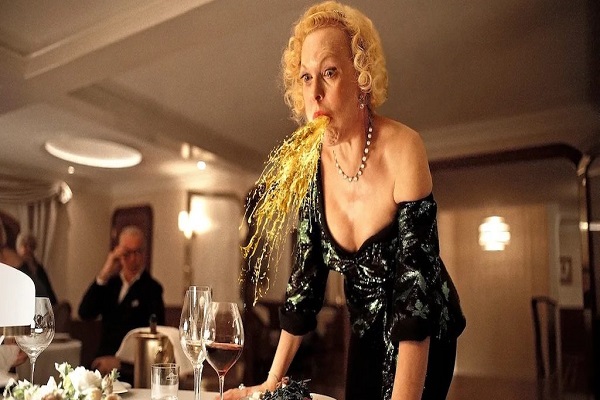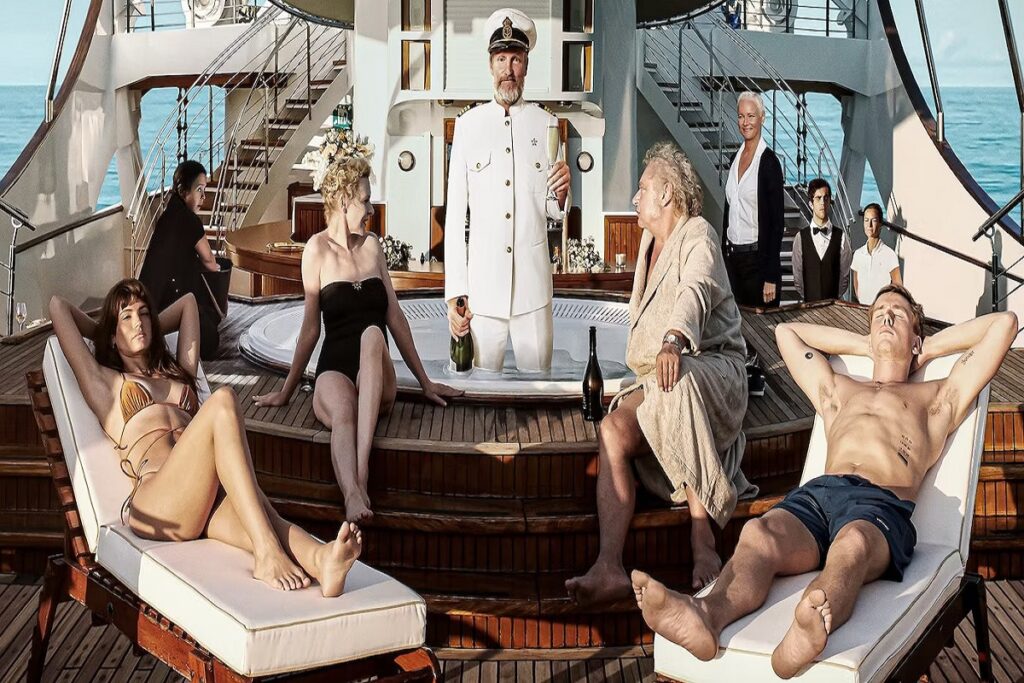Ruben Ostlund is known for mocking the socioeconomic system of the modern world. His wild entertaining rollercoaster for adults Triangle of Sadness is not an exception. He never forgets to point out the hypocrisies, loopholes, and absurdities of modern society. In the 1st part of the film, he mocks the fashion world and argues against gender bias. In the 2nd part, he mocks the modern capitalist society inside a luxurious yacht. In the 3rd part, he completely changes the power dynamics, and a toilet manager commands a team full of uber-rich and famous people. Even though apparently Triangle of Sadness looks like a big-scale comedy film, it focuses on multiple important socioeconomic issues like gender inequality, class divisions, racial discrimination, stereotyping, the influence of social media, and the overall capitalist mindset. Filmmaker Ruben Ostlund clearly shows the emptiness of the modern world where a female model wants to be a trophy wife. He clearly shows how the most fortunate struggle to survive during adversities. The apparent social structure doesn’t always remain intact.
The film starts with a male model named Carl (Harris Dickinson) attending an awkward fashion audition with other male models. He is in a relationship with a female model and social media influencer named Yaya (Charlbi Dean). They engage in a tiff over the payment of the dinner bill. As per Carl, both of them should share the dinner expense and Yaya should not expect that Carl pays the bill always. But, Yaya expects Carl to pay the bill as it ensures that he will take care of his wife in the future when she will not work anymore. She tells him that she wants to be a trophy wife and they are in a relationship as it garners social media attention. Yaya’s statement irritates and frustrates Carl immensely.

Yaya gets a free pass to a luxurious yacht in exchange for social media promotion. The yacht is full of uber-rich passengers like Russian manure magnet Dimitry (Zlatko Buric) and his wife Vera (Sunnyl Melles), British weapon mogul Winston (Oliver Ford Davies) and his wife Clementine (Amanda Walker), a wheelchair-sitting German lady named Therese (Iris Berben) who can speak only one line in German after she suffered a stroke, and a tech mogul name Jarmo (Henrik Dorsin). The crew led by Paula (Vicki Berlin) is always at the service of the guests who don’t hesitate to make bizarre requests. Vera asks all the crew members including the kitchen staff to swim in the sea and Paula accepts that bizarre request. Carl complains about a mechanic who works bare-body and attracts Yaya’s attention. The ship’s captain Thomas (Woody Harrelson) drinks to the fullest and encloses himself in his cabin.
In the evening, the guests are invited to the captain’s dinner. After being asked by Paula multiple times, finally, Thomas dresses up for welcoming the guests at the captain’s dinner. A severe storm pushes the yacht all around injuring several guests. Some guests feel terrible seasickness and start vomiting. The yacht gets flooded with sewage water and disconnected from the power supply. Thomas and Dimitry start debating over socialism and capitalism by uttering multiple famous quotes on the intercom. In that turbulent situation, pirates attack and capsize the yacht. Only a few guests are able to escape from the yacht to an aloof island.
The group on that aloof island consists of Carl, Yaya, Dimitry, Vera, Therese, Jarmo, Paula, toilet manager Abigail (Dolly de Leon), and ship mechanic Nelson (Jean-Christophe Folly). Abigail gains the commanding position of the group because of her survival skills including catching fish, setting fire, and cooking. She enjoys her private space inside the lifeboat where Carl provides her with sexual favor in exchange for food. Yaya becomes jealous. Jarmo kills a wild donkey with a stone. The group totally depends on Abigail and does not dare to question her authority. Yaya and Abigail go hiking and discover a luxury resort with an elevator. However, Abigail is not interested to enter the resort. Yaya offers Abigail a better job as her assistant when they are rescued from the island. But, hesitatingly, Abigail approaches to kill Yaya from behind with a rock. Carl guesses ill consequences and runs frantically to reach them.
Through Triangle of Sadness, filmmaker Ruben Ostlund makes a wild entertaining rollercoaster for adults. Even though it looks like a big-scale entertaining comedy film, it has the typical Ostlund-style social commentary. The issues that Ostlund focuses on through this film are not limited to a particular country but are seen all over the world. In this film, Ostlund shows that premium brands look at the world in a cynical way and sometimes look down upon the poor strata of society. So, it is not a surprise that their models don’t smile and see the outer world differently. However, the warm and soft touches of the regular brands are reflected in the warm and gentle smiles of their models. Through a simple scene, Ruben Ostlund differentiates between the rich and middle class or poor society.

Another important issue that Ostlund points out in this film is gender bias. Even though Yaya earns much more than Carl, she expects him to pay the dinner bill. Carl tells her that they should share the expenses and she should not expect Carl to pay the bill all the time. On the other hand, by paying the bill, Yaya wants to test whether Carl will take care of her when she will not work anymore. Director Ostlund vividly shows the prejudice of society where males are expected to bear all the expenses. It is quite disheartening that these prejudices, still, exist in modern society. The modern world cannot prosper without a society where everybody is treated equally irrespective of class, gender, race, caste, and wealth.
In Triangle of Sadness, filmmaker Ruben Ostlund highlights the emptiness of modern life, relationships, and the influence of social media on the modern world. Yaya tells Carl that she wants to be a trophy wife and they are in a relationship as it garners social media attention. Humans in modern society run behind virtual popularity, but not spiritual fulfillment. Selfish interests never form strong and stable relationships. When the most intimate relationships are broken, life seems to be futile. Love cannot blossom in a selfish and toxic environment. When our social media handles are flooded with millions of followers, we struggle to overcome loneliness with only a very few bosom friends in real life. Humans suffer each day in the mechanical and virtual modern world.
During the 2nd part of the film, filmmaker Ruben Ostlund shows the class difference and how society as a whole indulges and accepts it. When Vera asks all the crew members to swim in the sea, Paula accepts her request and does not protest. Even the kitchen staff are forced to swim in the sea. Ostlund places his characters in awkward situations and observes their absurdities. The high-profile captain’s dinner ends up being a complete mess. Vomiting and flooding of the sewage water make the situation hell. In that horrible situation, Captain Thomas and Dimitry debate over socialism and capitalism. Ostlund clearly shows how the most fortunate strata of society miserably fail to handle an adverse situation. He points out class division and racism. While the toilet manager and the ship mechanic belong to third-world countries, the high-profile guests are all white and belong to first-world countries. Amid a wild entertaining rollercoaster ride, the viewers should not miss out on director Ostlund’s social commentaries and quintessential satire on the uber-rich strata of society.
One of the most important aspects of Triangle of Sadness is the last scene. Ruben Ostlund deliberately keeps the film open-ended. The most important question is – Does Abigail kill Yaya? Or, Does she stop at the last moment and accept Yaya’s offer? Ruben Ostlund wants viewers to connect the dots. Films always do not give answers. The basic objective of any art form including films is to ask questions. During the third part of the film, Ostlund completely changes the power dynamics. Even though Abigail serves the luxury yacht as the toilet manager, she becomes the boss of the stranded group because of her survival skills on that aloof island. She enjoys authority and also her private space in the lifeboat. However, when Yaya discovers the resort and the elevator, naturally, she is not happy as she will lose her authority now once the group comes to know about the resort. If she accepts Yaya’s offer, she will again be a blue-collar worker without any authority or power that she enjoys now on the island. So, the resort discovery does not go well with her. Also, Abigail now enjoys her affair with the young and handsome Carl. If the group members regain their position, she will lose Carl. So, it is not a bizarre idea to kill Yaya. However, if she kills Yaya, the group members will soon come to know about this heinous crime. When Yaya will not return to the group, the group members including Carl will surely look for her. She is very much aware of the consequences. That’s the reason, she hesitates to attack Yaya from behind. So, there is no plain and simple answer. The ending of the story depends on the imaginations of the viewers.
The screenplay written by Ostlund himself is witty, satirical, and overall hilarious. Ostlund’s social commentary can be felt throughout the film. Dialogues are expressive and elaborate the characters. Ostlund clearly shows that both socialist captain Thomas and Capitalist mogul Dimitry fail to do their duties. Ideologies that don’t serve society are useless. Triangle of Sadness will be remembered for the late Charlbi Dean and Dolly De Leon. Unfortunately, Charlbi passed away before the film’s release. She looks glamorous, seductive, elegant, and overall beautiful. Dolly De Leon brilliantly portrays Abigail commanding the stranded group on the aloof island when the power dynamics change. She herself is from the Philippines and represents the working class of third-world countries. Her portrayal of Abigail has received widespread critical acclaim. Harris Dickinson looks young, handsome, and promising. In the first part of the film, he efficiently puts forward Carl’s arguments against gender bias. As the drunkard captain, Woody Harrelson justifies his character.
As Triangle of Sadness is a large-scale film, the cinematography is complex and cinematographer Fredrik Wenzel used multiple advanced techniques. He used a robotic arm attached to the camera for filming the car scene with Carl and Yaya. The entire set including the camera was placed on a gimbal for the vomiting scene. The movement of the yacht was replicated by the movement of the gimbal. Wenzel used 29 mm wide-angle lenses so that the background could be significantly captured. So, the film has a long depth of field. In Triangle of Sadness, music directors Mikkel Maltha and Leslie Ming use multiple contemporary soundtracks including Born Free by M.I.A., The Ocean by Linnea Olsson, Lady (Hear Me Tonight) by Modjo, and New Noise by Refused. However, Marea (We’ve Lost Dancing) by Fred Again and The Blessed Madonna in the last scene creates maximum impact. Fred Again and The Blessed Madonna created this music during covid time to spread positivity and optimism. Director Ostlund included this soundtrack for the same purpose. He wants to bring optimism to cool down the atmosphere after a wild rollercoaster ride. No matter how badly we are stuck in the present situation, we should always be optimistic. Hope begins when despair ends. Director Ruben Ostlund took as many as 23 takes for a single shot, and the vomiting scene during the captain’s dinner was edited over a period of six months. So, the viewers can guess the enormous effort put in during editing by Ostlund himself and Mikel Cee Karlsson. Managing the editing of this kind of wild rollercoaster film with excellence is not an easy job.
Another important aspect of Triangle of Sadness is the production design. Production designer Josefin Asberg has done an incredible job. The viewers will not be able to realize that most of the yacht scenes were filmed in a studio and not on the yacht. It is not an easy job to build the set exactly like the interior of a luxurious yacht. However, the most significant and toughest part of the production design is during the captain’s dinner. The entire set was built on a gimbal 2 meters up the ground and then, it was moved all around to create the turbulence in the sea and the subsequent seasickness. Only an incredibly skilled expert can replicate such a big-scale mess to be filmed. Triangle of Sadness won the prestigious Palme d’Or at the 2022 Cannes Film Festival. It was nominated for Best Motion Picture – Musical or Comedy at the 80th Golden Globe Awards where Dolly de Leon was nominated for Best Supporting Actress. The film was nominated for Best Actress in a Supporting Role, Best Original Screenplay, and Best Casting at the 76th BAFTA Awards. Triangle of Sadness was also nominated for Best Picture, Best Director, and Best Original Screenplay at the 95th Academy Awards.
